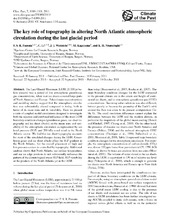The key role of topography in altering North Atlantic atmospheric circulation during the last glacial period
Peer reviewed, Journal article
Published version
Permanent lenke
https://hdl.handle.net/1956/9431Utgivelsesdato
2011-10-18Metadata
Vis full innførselSamlinger
- Geophysical Institute [1198]
Originalversjon
https://doi.org/10.5194/cp-7-1089-2011Sammendrag
The Last Glacial Maximum (LGM; 21 000 yr before present) was a period of low atmospheric greenhouse gas concentrations, when vast ice sheets covered large parts of North America and Europe. Paleoclimate reconstructions and modeling studies suggest that the atmospheric circulation was substantially altered compared to today, both in terms of its mean state and its variability. Here we present a suite of coupled model simulations designed to investigate both the separate and combined influences of the main LGM boundary condition changes (greenhouse gases, ice sheet topography and ice sheet albedo) on the mean state and variability of the atmospheric circulation as represented by sea level pressure (SLP) and 200-hPa zonal wind in the North Atlantic sector. We find that ice sheet topography accounts for most of the simulated changes during the LGM. Greenhouse gases and ice sheet albedo affect the SLP gradient in the North Atlantic, but the overall placement of high and low pressure centers is controlled by topography. Additional analysis shows that North Atlantic sea surface temperatures and sea ice edge position do not substantially influence the pattern of the climatological-mean SLP field, SLP variability or the position of the North Atlantic jet in the LGM.
Utgiver
Copernicus PublicationsEuropean Geosciences Union

